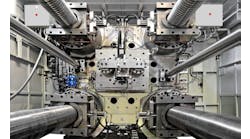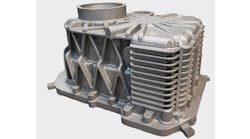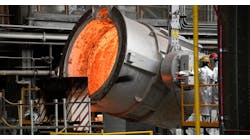Graphite/Metal Alloy Extends Material Life in High-Temperature Processes
American Cast Iron Pipe Co. (Acipco) produces a varied array of finished products for waterworks, and the capital goods and energy markets, such as ductile-iron pipe and fittings, fire hydrants, valves and pumps, centrifugally cast steel tubes and static castings, and fabricated assemblies. Other products include electric-resistance-welded pipe and spiral-welded steel pipes.
The ductile-iron pipe is offered in diameters from 4 to 64 in., and fittings are available with Acipco’s Fastite joint assembly, and also standard mechanical, ball, and restrained-joint pipes.
Annealing, or controlled heat-treating, is an essential production stage in finishing these pipe products. Annealing involves heating the individual products to 900°F in controlled atmospheres for extended periods, and this process is highly demanding on the equipment involved. Graphalloy — a graphite/metal alloy designed to last in high temperature applications, supplied by Graphite Metallizing Corp. — is used to produce bushings that last at least 12 times as long as units made from various other materials used in similar process.
The bushings are used in rollers for a table that receives ductile-iron pipe exiting an annealing chamber for smaller-diameter (4-16 in.) pipes. The rollers straighten misaligned pipes, but in the past bearings sometimes locked up suddenly and prevented the rollers from working, making it necessary to stop the line and correct misalignment problems.
“We typically installed new bushings during our summer shutdown and they failed sometimes in less than a month or two, so we had to go the rest of the year without the rollers being operational,” said Charlie Carter, maintenance foreman for Acipco’s Birmingham, AL, plant. “Then we heard about Graphalloy. We installed these bushings over a year ago and during the last shutdown we checked them, and there was no noticeable wear. We have significantly reduced our maintenance time and streamlined our production flow resulting in an increase of production capacity.”
Heat causes bearings to fail
At the plant in Birmingham, ductile iron pipe emerges from the annealing chamber and is loaded on to rollers, still just below the oven temperature. “The rollers are needed because sometimes the pipe ‘walks’ in one direction or the other inside the oven and comes out at an angle to the chain,” Carter explains. “This can be a problem because if the pipe gets badly out of alignment it could hang up on a column and make it necessary to shut down the line to free it.
“The rollers and two angle braces are designed to put the pipe back into alignment automatically as it passes over them. The problem we had in the past was that the rollers would freeze up, and when that happens they stop realigning the pipe. That meant that if the pipe was out of alignment we had to stop the line and straighten the pipe by hand, creating costly down-time.”
Carter says Acipco tried several different types of roller bearings and high-temperature greases to solve the problem. But, grease degraded or evaporated relatively quickly. When that happened, the roller bearings would eventually be damaged and freeze up. “For a number of years, we would replace the bearings every year during the plant shutdown,” Carter said. “But within a month or two they froze up and there was no way to free them up. We couldn’t take the time to shut down the line to replace the bearings so we had wait until the next downtime to repair. This was an annoying problem and one that I spent time trying to resolve whenever I had the chance.”
Trying a new bushing material
Carter searched for a bearing material that could match the demands of the application. “Two years ago we tried a cast-iron bushing that works without any lubrication,” he said. “But it still didn’t survive in this application, primarily because of particles of sand that remain on the pipe as a residue from the molds that we use to cast them. The sand got into the bearings and caused them to fail rather quickly.”
A salesman for a bearing distributor suggested a graphite alloy bearing material designed to work at high temperatures without any lubrication. Graphalloy is a self-lubricating bushing material that requires neither grease nor oil, survives run-dry conditions, and eliminates galling and seizing in hot and dry conditions. The material works at temperatures up to 1,000°F (525°C) where oil-based lubricants burn off or oxidize and plastics fail. It maintains its integrity even when submerged in hostile liquids such as acids, alkalis, hydrocarbons, black liquor, and liquid gases.
Graphite/metal alloys take advantage of graphite’s special properties: it is compared to a deck of cards: individual layers slide off the top surface easily. This phenomenon gives the material a self-lubricating ability found in no other material. Graphalloy’s self-lubricating features mean the operator can eliminate grease or oil that normally evaporates, congeals, or solidifies causing premature failure. The graphite matrix can be filled with a variety of impregnants to enhance chemical, mechanical and tribological properties. The material provides a constant, low coefficient of friction rather than just a surface layer, helping to protect against catastrophic failure. Lubrication is maintained even during linear motion; lubricant is not drawn out, and dust is not pulled in. Graphalloy wear components also improve reliability during low speed operation, frequent starts and stops, and switchovers from standby to continuous running. Graphalloy bushings are available in more than 100 grades of material in any desired size or geometry, including cylindrical, with or without grooves; flange or double flange; split; and metal-backed.
New material lasts for a year without any wear
Graphite Metallizing’s technical staff told Carter they were confident that the material would endure in this application, and they helped to specify bushings that fit the application with minimal modifications. Carter ordered a set of Graphalloy bushings and installed them in pillow blocks in advance of a planned shutdown. When the shutdown arrived, he installed the pillow blocks on the annealing line. “Once we installed the new bushings,” he said, “they just continued to work without any problems for the entire year until the next shutdown.
“During the second shutdown we disassembled the pillow blocks to see how the bushings looked. They showed no signs at all of any wear so we simply put them back together again.”
The key advantage of the new bushings is the rollers now function as originally designed by automatically straightening the pipe as it emerges from the annealing chamber. “The new bearings are performing much better than we ever hoped,” according to Carter. “We no longer have to worry about the pipe getting badly out of alignment and hanging up the cooling chain. This saves us the need to shut down the line when this happens. We have also saved the money and time that was required in the past to replace the bearings during shutdown.”
For Acipco, using Graphalloy bushings solved what had become an annoying and costly problem. Since the first bushing has not yet been replaced, it is too soon to tell exactly how long it will last. But, it seems likely it will last for several years without requiring any maintenance or lubrication. Keeping rollers operating under tough conditions increases production and reduces maintenance expenses. Just as important, Carter and crew have more time to address other maintenance concerns.








